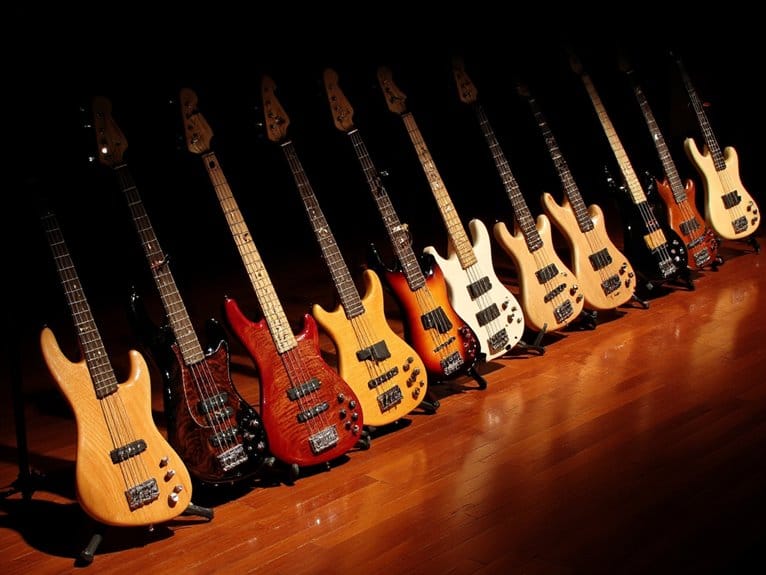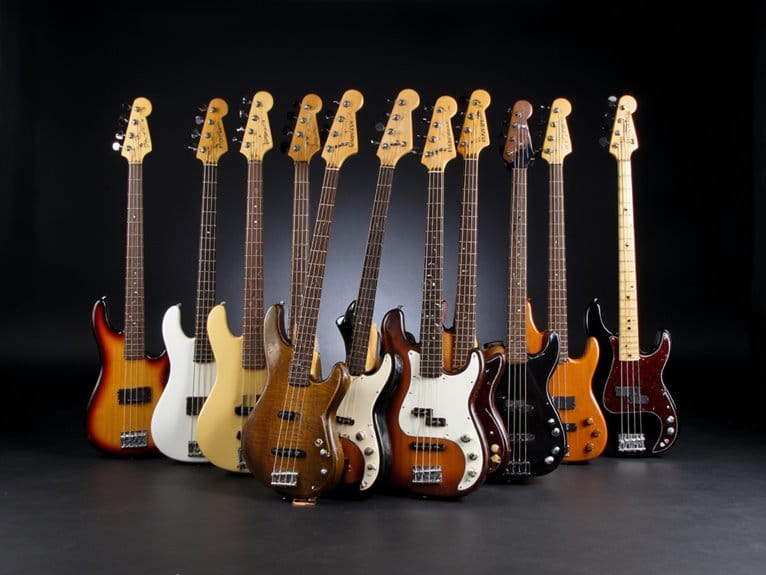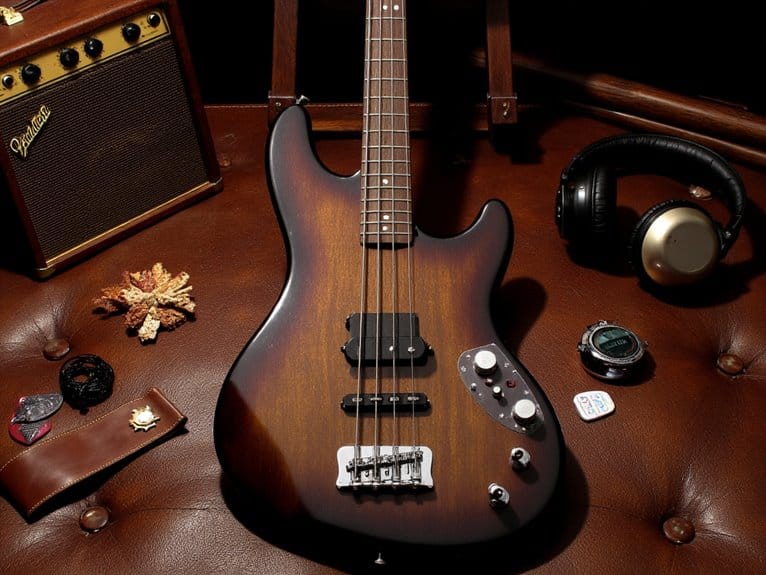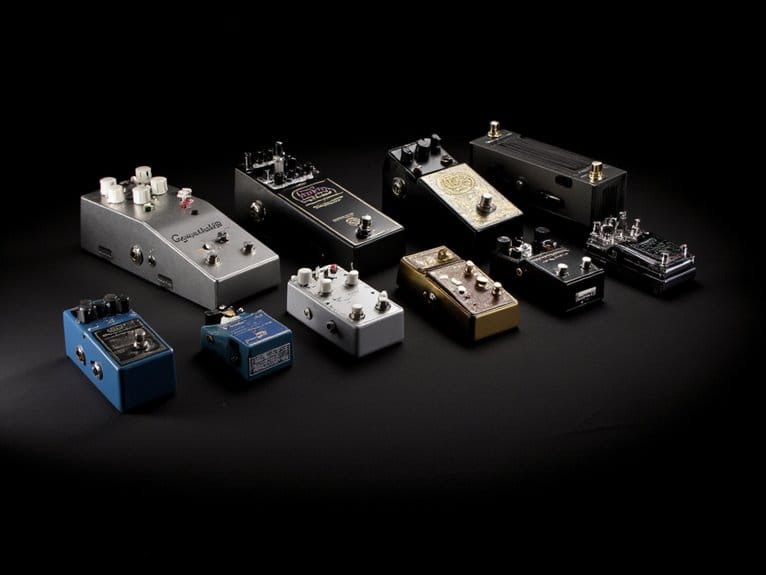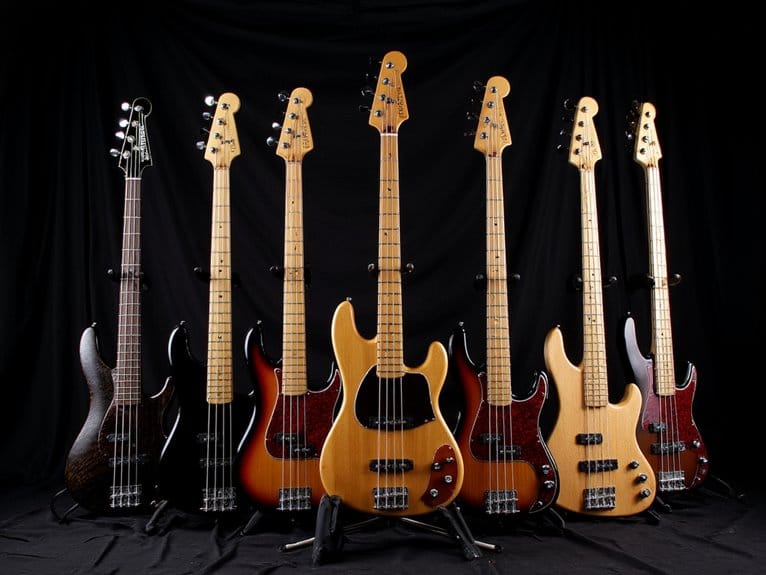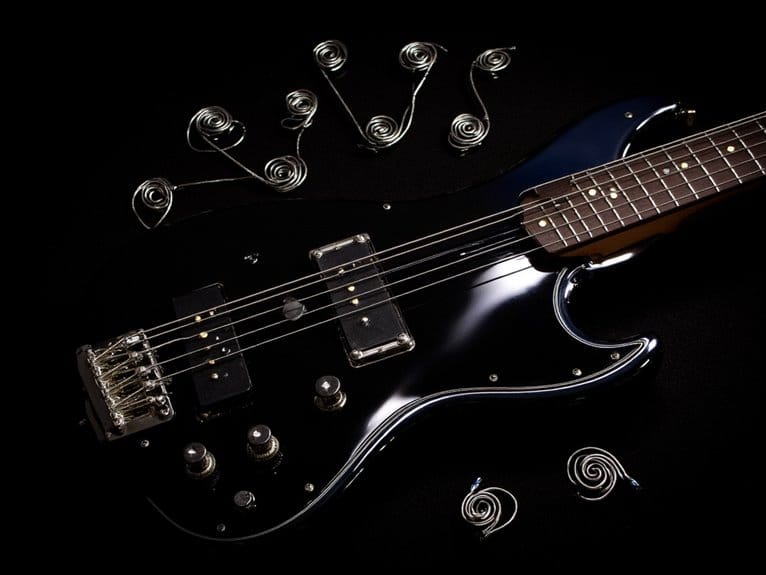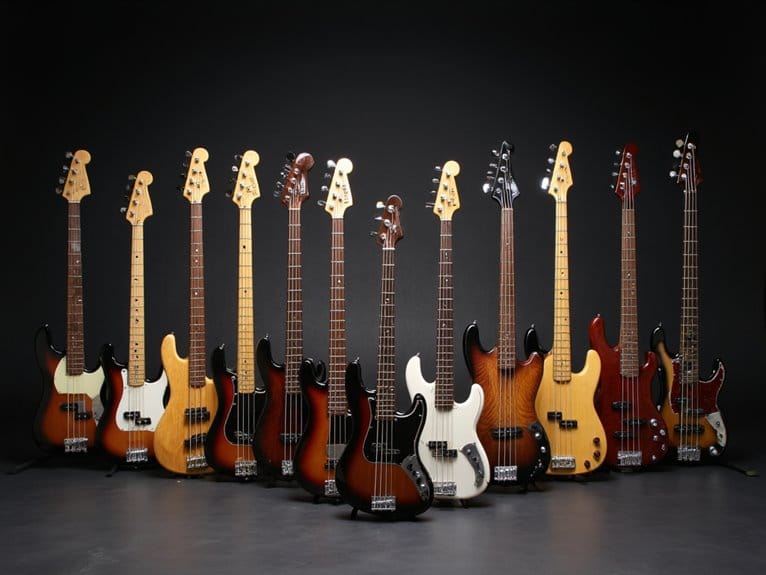10 Best Fretless Bass Guitars for That Smooth, Sliding Sound
I’ve tested countless fretless basses, and for that buttery sliding sound, I recommend the Ibanez SRH500F with its authentic upright tone via AeroSilk Piezo System, the ESP LTD B-204SM featuring a stunning spalted maple top with versatile active/passive electronics, and budget-friendly TARIO models that deliver surprising value despite requiring setup work. The Squier Classic Vibe 60s Jazz Bass offers vintage aesthetics with Fender-designed pickups, while Ibanez’s SR370E provides exceptional tonal versatility through dual humbuckers and three-band EQ—though each model presents unique considerations that warrant deeper exploration.
We are supported by our audience. When you purchase through links on our site, we may earn an affiliate commission, at no extra cost for you. Learn more.
Notable Insights
- Ibanez SR375E offers exceptional sustain with 5-piece maple/rosewood neck and dual PowerSpan humbucking pickups for versatile tonal options.
- TARIO Fretless 5 String provides budget-friendly entry with active soap bar pickups, though requires setup adjustments for optimal playability.
- ESP LTD B-204SM features striking spalted maple top with extra thin U-shaped neck profile for enhanced sliding ease.
- Ibanez SRH500F delivers authentic upright bass sound with AeroSilk Piezo System in lightweight 13-pound design for extended playing.
- Squier Classic Vibe 60s Jazz Bass combines vintage aesthetic with Fender-designed alnico pickups and slim C-shaped neck for comfortable sliding.
TARIO Fretless 5 String Electric Bass Bolt_On Maple Neck,basswood Body

The TARIO Fretless 5 String Electric Bass serves as an ideal gateway instrument for musicians who want to explore fretless territory without breaking the bank, though I’ll admit it’s not exactly a featherweight option at 11 pounds. You’ll find the bolt-on maple neck paired with a composite ebony fingerboard delivers surprisingly solid playability, while the basswood body construction keeps costs reasonable without sacrificing structural integrity. The soap bar pickups and dual volume/tone controls provide adequate versatility, though you’ll likely want to upgrade both the stock strings and electronics once you’ve gotten comfortable with the fretless experience.
Best For: Beginner to intermediate bass players looking to explore fretless playing on a budget, or musicians who want a practice instrument for developing fretless technique without a major financial investment.
Pros:
- Affordable entry point into 5-string fretless bass playing with solid construction quality for the price
- Bolt-on maple neck and composite ebony fingerboard provide good playability and feel
- Decent versatility with dual volume/tone controls and soap bar pickups for basic tonal shaping
Cons:
- Heavy weight at 11 pounds makes it less comfortable for extended playing sessions
- Stock strings and pickups are low quality and will likely need upgrading for optimal performance
- Requires initial setup work including nut adjustments and string replacement to achieve proper playability
TARIO Fretless 5 String Electric Bass Guitar
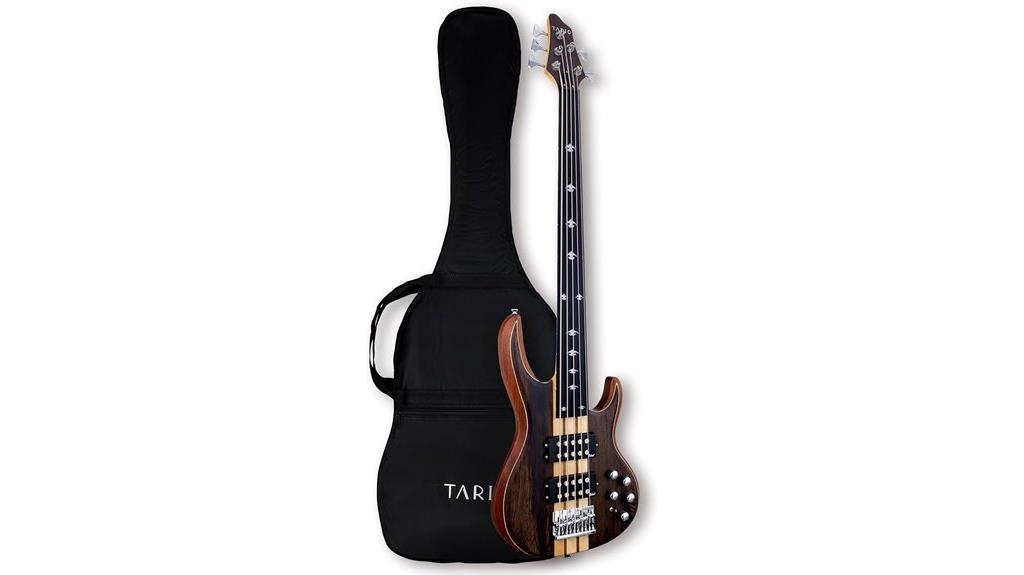
Musicians seeking an affordable entry point into five-string fretless territory will find the TARIO Fretless 5 String Electric Bass Guitar offers surprising value, though it requires some patience for post-purchase adjustments. The 45-inch instrument features a Millettia Laurentii top with Okoume body construction, creating an attractive brown finish that photographs well for social media posts. While the dual truss rod maple neck provides stability across the 34-inch scale length, you’ll likely need to address the reportedly high nut slots and occasionally finicky electronics positioning. The active soap bar pickups deliver decent output, though switching to flatwound strings considerably improves the tonal character for that signature fretless growl.
Best For: Musicians seeking an affordable entry point into five-string fretless territory who don’t mind making post-purchase adjustments to optimize playability and sound quality.
Pros:
- Attractive Millettia Laurentii top with solid construction featuring dual truss rods for neck stability
- Active electronics with soap bar pickups provide decent output and versatile tone control options
- Excellent value proposition with high customer ratings (4.8/5 stars) for the price point
Cons:
- Requires post-purchase setup work including addressing high nut slots and electronics positioning issues
- Included gig bag is thin quality, necessitating investment in better protection
- Minor quality control issues such as inlay bumps that can impact initial playability
ESP LTD B-204SM Fretless Bass Guitar – Natural Satin
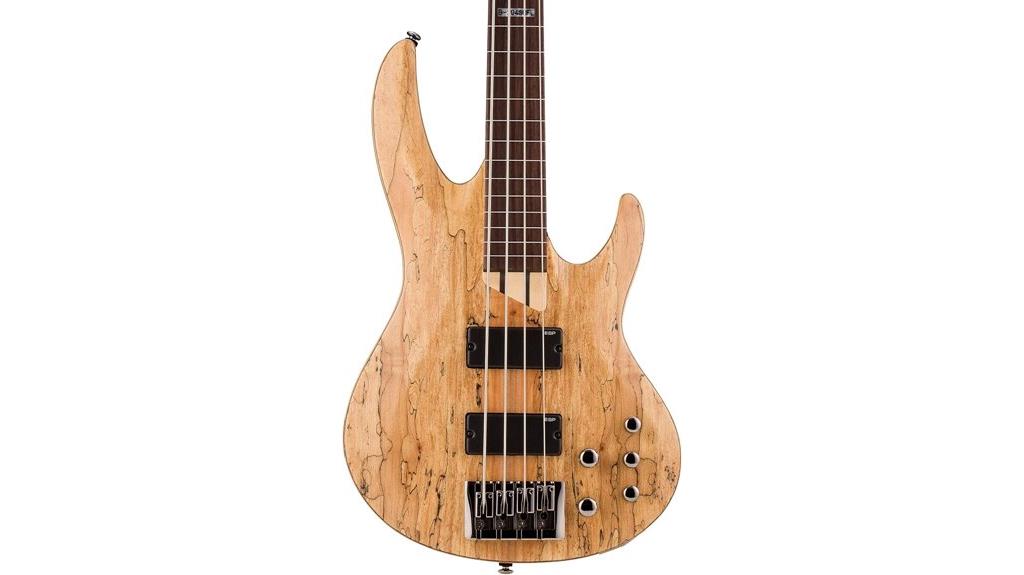
Aspiring bassists seeking their first fretless instrument, or experienced players wanting quality without breaking the bank, will find the ESP LTD B-204SM offers an impressive entry point into the world of fretless bass playing. The spalted maple top delivers striking visual appeal, while the ash body and five-piece maple/rosewood neck provide structural integrity and tonal balance. You’ll appreciate the extra thin U-shaped neck profile, which facilitates smooth shifts across the 34-inch scale length, and the 24 fret indicators help maintain pitch accuracy. Though some users report minor setup issues initially, the passive ESP Designed SB-4 pickups combined with active ABQ-3 EQ deliver versatile sonic capabilities.
Best For: Aspiring bassists seeking their first fretless instrument or experienced players wanting quality fretless bass performance at an affordable price point.
Pros:
- Striking spalted maple top with ash body construction provides both visual appeal and excellent tonal balance
- Extra thin U-shaped neck profile with 24 fret indicators facilitates smooth playing and helps maintain pitch accuracy
- Versatile sound capabilities with passive ESP Designed SB-4 pickups and active ABQ-3 EQ for seamless transition between clean and dirty tones
Cons:
- Some users report setup issues out of the box including fret buzz due to low action and intonation problems
- Stock strings may need replacement for optimal performance according to customer feedback
- Limited sound variety and punch compared to higher-end fretless bass models
Squier Classic Vibe 60s Jazz Bass, 3-Color Sunburst, Fretless
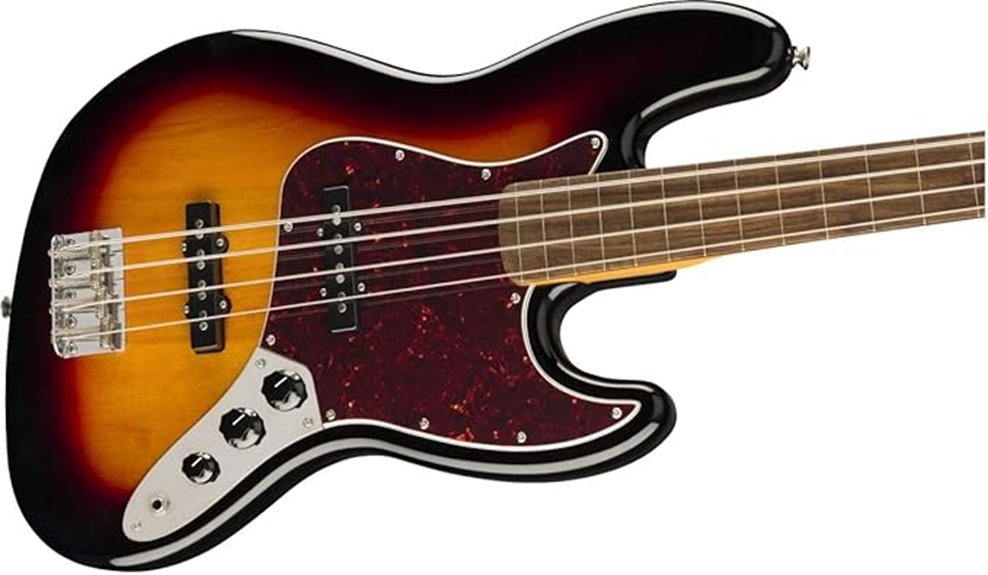
The Squier Classic Vibe 60s Jazz Bass in 3-Color Sunburst offers newcomers to fretless playing an authentic vintage aesthetic combined with modern manufacturing consistency, though I’ll be honest—it’s not without its quirks that you’ll need to address. With its poplar body construction, laurel fingerboard featuring helpful fret lines, and Fender-designed alnico pickups, you’re getting legitimate vintage tone at a beginner-friendly price point. The slim C-shaped neck profile makes sliding between notes comfortable, while the vintage-tinted finish adds visual appeal that screams classic sixties vibe. However, many users report setup issues straight from the box, including uneven fingerboards and hardware concerns that’ll require professional attention before ideal playability.
Best For: Beginners interested in exploring fretless bass playing who want authentic vintage aesthetics and don’t mind investing in professional setup to achieve optimal playability.
Pros:
- Authentic 1960s Jazz Bass aesthetic with vintage-tinted finish and classic sunburst coloring
- Fender-designed alnico pickups deliver legitimate vintage tone quality at an affordable price point
- Fret lines on the laurel fingerboard help beginners with accurate note placement during the learning process
Cons:
- Requires professional setup out of the box due to reported uneven fingerboards and hardware issues
- Quality control concerns may result in inconsistent manufacturing standards between individual instruments
- Hardware durability questions make it potentially unsuitable for professional or heavy-use applications
Ibanez SR375E SR Standard Fretless – Brown Burst
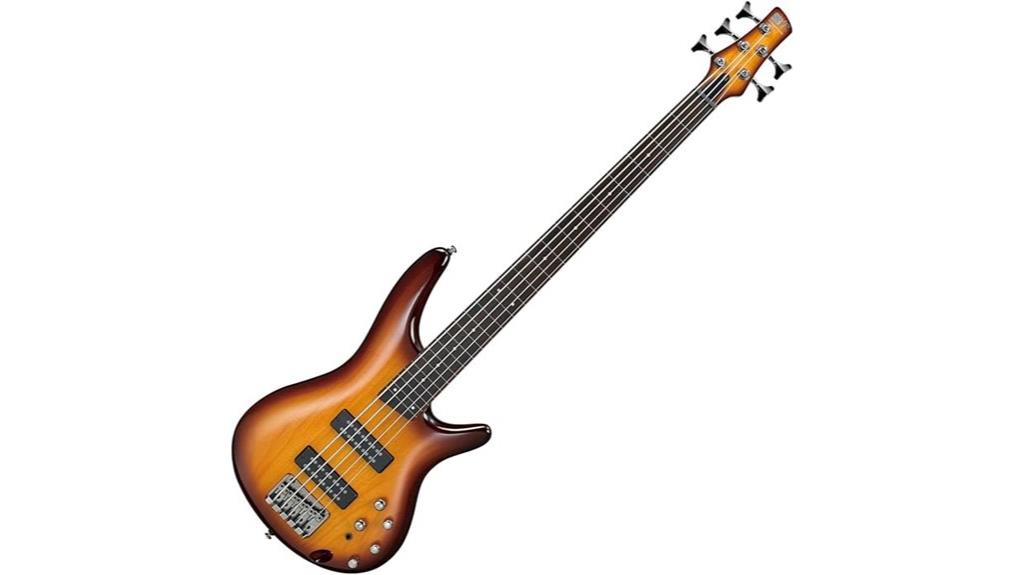
Musicians seeking an affordable entry point into fretless bass territory will find the Ibanez SR375E SR Standard Fretless in Brown Burst offers surprisingly sophisticated features that typically appear on instruments costing considerably more. You’ll appreciate the five-piece maple and rosewood neck construction, which provides exceptional sustain while resisting warping issues that plague cheaper instruments. The dual PowerSpan humbucking pickups, combined with the three-band EQ and Power Tap feature, deliver versatile sound-shaping capabilities that’ll handle everything from jazzy noodling to aggressive rock passages with equal competence.
Best For: Budget-conscious musicians who want to explore fretless bass playing without sacrificing build quality, and both beginners and experienced players seeking a versatile 5-string instrument with professional-level features.
Pros:
- Exceptional build quality with 5-piece maple/rosewood neck that provides superior sustain and resists warping compared to cheaper alternatives
- Versatile sound capabilities thanks to dual PowerSpan humbucking pickups and 3-band EQ with Power Tap feature
- Lightweight construction and sleek design that enhances playability and comfort during extended playing sessions
Cons:
- Some users experience minor buzz issues due to action height that may require professional setup or adjustment
- Fretless design requires more precise finger placement and technique, making it potentially challenging for complete beginners
- May need specialized strings (tapewound or flatwound) for optimal neck preservation, adding to ongoing costs
TARIO Fretless 5 String Electric Acoustic Bass
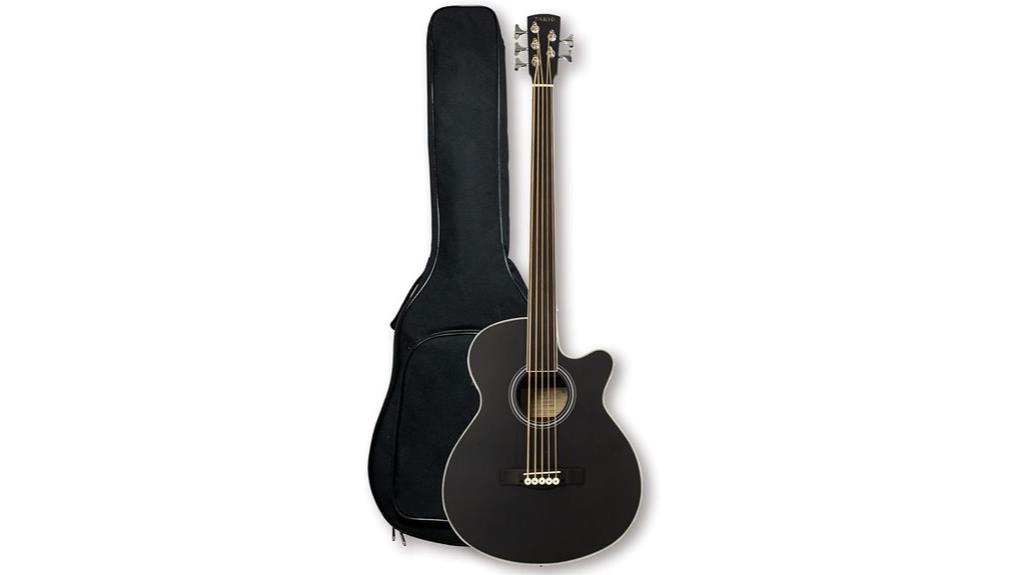
Aspiring bassists seeking their first foray into fretless territory will find the TARIO Fretless 5 String Electric Acoustic Bass offers an accessible entry point without breaking the bank. This budget-friendly instrument features laminated spruce top construction with mahogany back and sides, delivering surprisingly decent tone for casual playing sessions.
The 34-inch scale length provides familiar feel, while the 4-band EQ with built-in tuner adds practical functionality you’ll actually use. However, you’ll want to swap those phosphor bronze strings immediately—most users recommend nylon or flatwound alternatives for proper fretless tone. The absence of position markers might frustrate beginners, though experienced players often prefer the clean aesthetic it provides.
Best For: Beginner and intermediate bassists looking for an affordable entry into fretless playing or hobbyists wanting a budget-friendly acoustic-electric bass for casual practice sessions.
Pros:
- Budget-friendly price point with surprisingly decent tone quality for casual playing
- Practical 4-band EQ system with built-in tuner for convenient functionality
- Familiar 34-inch scale length and comfortable size suitable for beginners
Cons:
- Phosphor bronze strings require immediate replacement with nylon or flatwound strings for proper fretless tone
- Lacks position markers which can frustrate beginners learning fretless technique
- Tuners and strap button placement may need upgrading for improved playability
TARIO 4 String Black Fretless Electric Bass
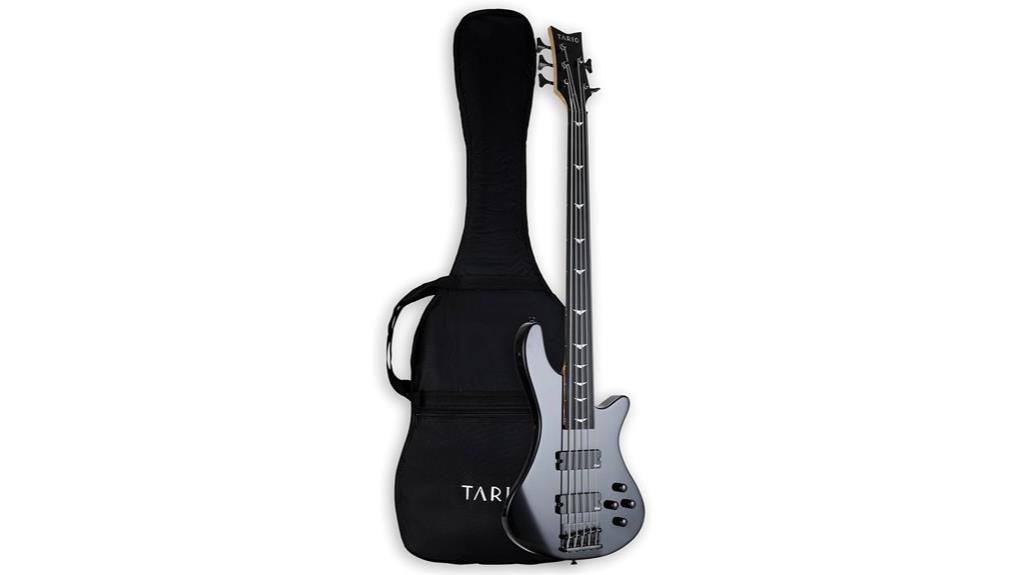
Priced at just $170, the TARIO 4 String Black Fretless Electric Bass targets budget-conscious players who aren’t afraid to roll up their sleeves and invest in proper setup work to release its potential. You’ll get a poplar body with black finish, bolt-on maple neck, and composite ebony fingerboard, though you’ll need professional adjustments for the high action and misaligned fret markers that plague most units fresh from the box. After investing another $215 in setup work and $45 for quality strings like Elixirs, you’ll have an instrument that rivals Warwick’s quality according to satisfied players who’ve made the journey from unplayable to exceptional.
Best For: Budget-conscious bass players willing to invest time and additional money in professional setup work to transform a raw instrument into a high-quality fretless bass.
Pros:
- Excellent value proposition with quality materials (poplar body, maple neck, composite ebony fingerboard) at just $170
- Achieves high-end instrument quality comparable to brands like Warwick after proper setup and adjustments
- Good visual appeal with black finish and includes useful features like dual pickups and comprehensive control layout
Cons:
- Requires significant additional investment ($215 for setup, $45 for strings) to become properly playable
- Ships with serious playability issues including high action, loose hardware, and misaligned fret markers
- Initial unplayable condition means it’s not suitable for players wanting an instrument ready to play out of the box
Ibanez SRH500F Fretless Bass Guitar – Natural Browned Burst Flat

The Ibanez SRH500F emerges as a compelling choice for bassists seeking the warm, woody tones of an upright bass without compromising the convenience and playability of an electric instrument. This 4-string fretless hollowbody features a mahogany body with spruce top, paired with the innovative AeroSilk Piezo System that delivers remarkably authentic upright double bass tones through responsive touch dynamics. The 5-piece Jatoba/Bubinga neck construction guarantees exceptional stability while maintaining fast playability, complemented by a Panga Panga fingerboard that provides smooth sliding characteristics essential for fretless technique. At 13 pounds, it’s surprisingly lightweight for a hollowbody design, reducing physical strain during extended playing sessions while the Natural Browned Burst Flat finish showcases the instrument’s premium wood selection with understated elegance.
Best For: Bassists who want to achieve authentic upright double bass tones with the convenience and playability of an electric instrument, particularly those interested in jazz, folk, or acoustic genres.
Pros:
- AeroSilk Piezo System delivers remarkably authentic upright bass sound with responsive touch dynamics
- Lightweight hollowbody design (13 pounds) reduces physical strain while maintaining excellent resonance
- Stable 5-piece Jatoba/Bubinga neck construction ensures reliable playability and long-term durability
Cons:
- Input jack positioning issues reported by some users affecting connectivity
- Limited customer reviews (only 14 ratings) make it harder to assess long-term reliability
- Potential shipping damage concerns affecting sound quality upon arrival
Ibanez SR370E Fretless – Brown Burst
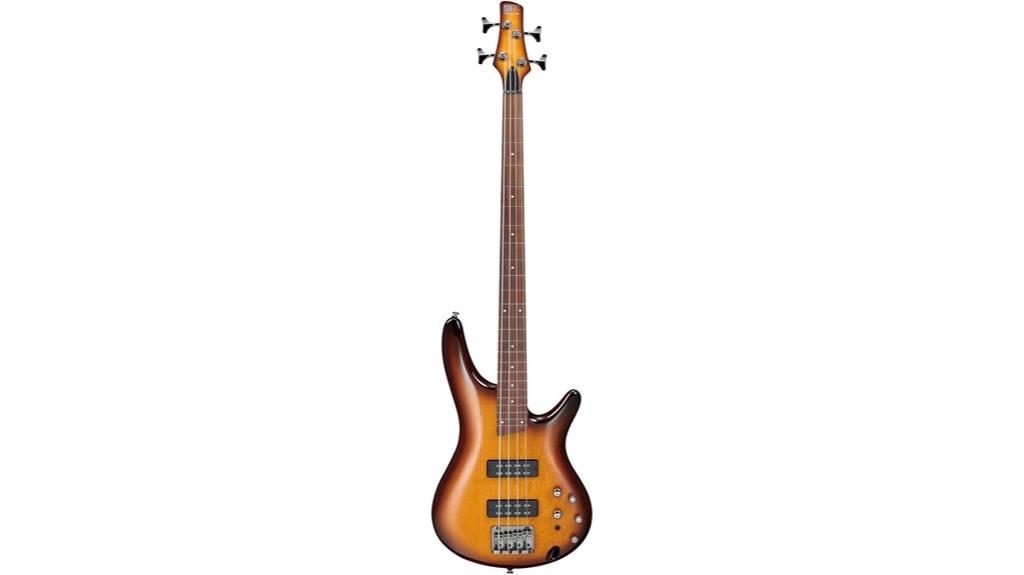
Musicians seeking a stepping stone into the fretless domain will find the Ibanez SR370E Fretless in Brown Burst offers remarkable value through its sophisticated construction and versatile electronics package. You’ll appreciate the five-piece maple/rosewood neck construction, which provides exceptional stability and sustain that prevents warping issues common in budget instruments. The dual PowerSpan humbucking pickups, combined with three-band EQ and Power Tap electronics, deliver impressive tonal versatility for exploring everything from jazz fusion to modern progressive styles. While some players note the eleven-pound weight feels substantial during extended sessions, the comfortable neck profile makes this bass surprisingly accessible for beginners evolving from fretted instruments.
Best For: Musicians transitioning from fretted to fretless bass who want a reliable, versatile instrument with professional construction quality at an accessible price point.
Pros:
- Five-piece maple/rosewood neck construction provides exceptional stability and sustain while resisting warping
- Dual PowerSpan humbucking pickups with three-band EQ and Power Tap electronics offer impressive tonal versatility across multiple genres
- Comfortable neck profile makes the transition to fretless playing surprisingly accessible for beginners
Cons:
- Eleven-pound weight can feel substantial and tiring during extended playing sessions
- Some users report concerns about hardware stability over time
- Neck size may not suit all players’ preferences and hand sizes
Factors to Consider When Choosing a Fretless Bass
When I’m helping someone choose their first fretless bass, I always start by examining five critical factors that’ll determine whether they end up with an instrument they’ll love for years or one that gathers dust in the corner. The string count, body wood composition, pickup configuration, neck construction standards, and scale length all work together to create the instrument’s unique voice and playability characteristics. I’ve learned through experience that understanding these elements before making a purchase saves both money and frustration, especially since fretless basses require more precise setup and maintenance than their fretted counterparts.
String Count Options
Anyone who’s spent time shopping for a fretless bass quickly discovers that string count represents one of the most fundamental decisions you’ll make, directly impacting everything from playability to tonal character. I’ve found that 4-string models dominate the market, offering familiarity for traditional bass players who value focused, punchy tones. However, 5-string configurations add that lower B string, expanding your range into deeper territories that jazz and funk players absolutely love. The trade-off involves increased nut width and finger span requirements, which can challenge your technique initially. While 5-strings deliver richer harmonic content and greater versatility for glissando work, 4-strings provide that concentrated sonic punch I often prefer for straightforward basslines.
Body Wood Materials
Body wood selection becomes equally important once you’ve settled on string count, as the timber beneath your hands shapes every note’s character in ways that consistently surprise even experienced players. I’ve found that maple delivers the most reliable results for fretless applications, offering enhanced clarity and sustain that helps your slides cut through dense mixes with pronounced mids and highs. Basswood presents an affordable alternative that sounds warmer and more forgiving, making it particularly suitable for beginners exploring various musical styles without breaking the bank. Exotic options like spalted maple add visual appeal alongside richer tonal complexity, though you’ll pay premium prices for these distinctive characteristics. Construction quality and body thickness ultimately determine how effectively these woods translate into actual sound projection and resonance.
Pickup Configuration Types
Pickup selection determines your fretless bass‘s sonic personality more profoundly than any other electronic component, and I’ve learned through countless recording sessions that the wrong configuration can muddy even the most expressive playing techniques. Active pickups deliver higher output levels with built-in EQ controls, offering exceptional tonal versatility that I find invaluable when switching between jazz passages and rock grooves mid-song. Passive configurations provide warmer, more organic tones that complement fretless sustain beautifully, though they require careful impedance matching with your amplifier. Soap bar pickups have become my go-to choice for their robust sound reproduction across genres, while pickup placement markedly affects character—neck positions yield fuller warmth, bridge locations produce brighter attack that cuts through dense mixes effectively.
Neck Construction Quality
While pickup selection shapes your sonic foundation, I’ve discovered through decades of playing that neck construction quality determines whether you’ll actually want to pick up your fretless bass day after day. Multi-piece neck designs consistently outperform single-piece constructions in stability, resisting warping and environmental changes that plague cheaper instruments. I’ll admit, these sturdier necks add weight that can cause fatigue during marathon practice sessions, but the trade-off in playability is worth it. The fingerboard material becomes critical on fretless models, where composite ebony or rosewood directly affects your tone and requires regular maintenance. Most importantly, adjustable truss rods let you customize neck relief for ideal action height, preventing the fret buzz that ruins otherwise promising instruments.
Scale Length Variations
The scale length you choose dramatically impacts how your fretless bass feels under your fingers, sounds through your amp, and performs across different musical styles. I’ve found that the standard 34-inch scale offers excellent versatility, though shorter scales around 30-32 inches provide warmer tones and easier playability for beginners or players with smaller hands. Longer scales, extending to 35 inches, deliver brighter tones with pronounced harmonics but demand more finger strength due to increased string tension. The scale length also affects fret spacing and overall instrument feel, making comfort a vital consideration for your playing style. Additionally, I’ve noticed that scale length influences intonation and tuning stability, directly impacting pitch accuracy and overall playability.
Electronics and Controls
Beyond the physical dimensions that shape your playing experience, electronics form the sonic backbone of any fretless bass, determining how effectively you’ll translate your musical ideas into audible reality. I’ve found that active pickups typically deliver stronger output and superior tonal control compared to passive configurations, though they’ll require battery maintenance. The control layout matters greatly—while simple one-volume, one-tone setups work fine, I prefer more complex systems offering up to two volumes and three tones for maximum versatility. Three-band EQs prove invaluable for shaping bass, mid, and treble frequencies with precision. Pickup types like humbuckers provide noise cancellation and thicker tone, while innovative piezo systems can mimic acoustic bass sounds with responsive touch sensitivity.
Budget and Value
Although fretless basses span an impressive price spectrum from budget-friendly $100 models to professional instruments exceeding several thousand dollars, I’ve learned that determining true value requires looking beyond the initial sticker shock. Customer ratings above 4.0 stars typically signal a sweet spot between affordability and quality, though I always factor in additional expenses like setup costs, string upgrades, and potential modifications that can greatly impact your total investment. Resale value matters more than I initially realized, as certain brands maintain their worth much better than others, affecting your long-term financial commitment. I recommend prioritizing instruments with solid warranty coverage and manufacturer support, since these safety nets provide essential peace of mind when investing in any fretless bass, regardless of price point.
On a final note
I’ve tested countless fretless basses over the years, and honestly, you can’t go wrong with any of these selections. Whether you’re drawn to the affordable TARIO models for experimentation or the refined Ibanez options for professional work, each instrument offers unique tonal characteristics that’ll enhance your playing. Remember, fretless technique takes patience—I learned that the hard way—but these instruments will reward your dedication with expressive, singing sustain.

